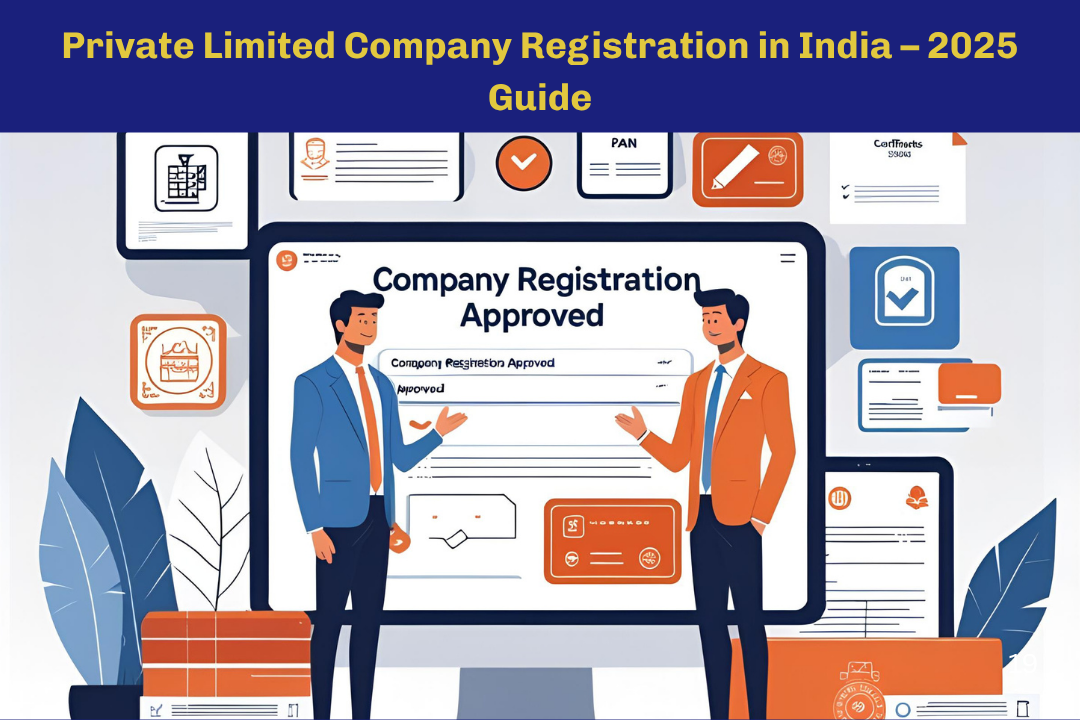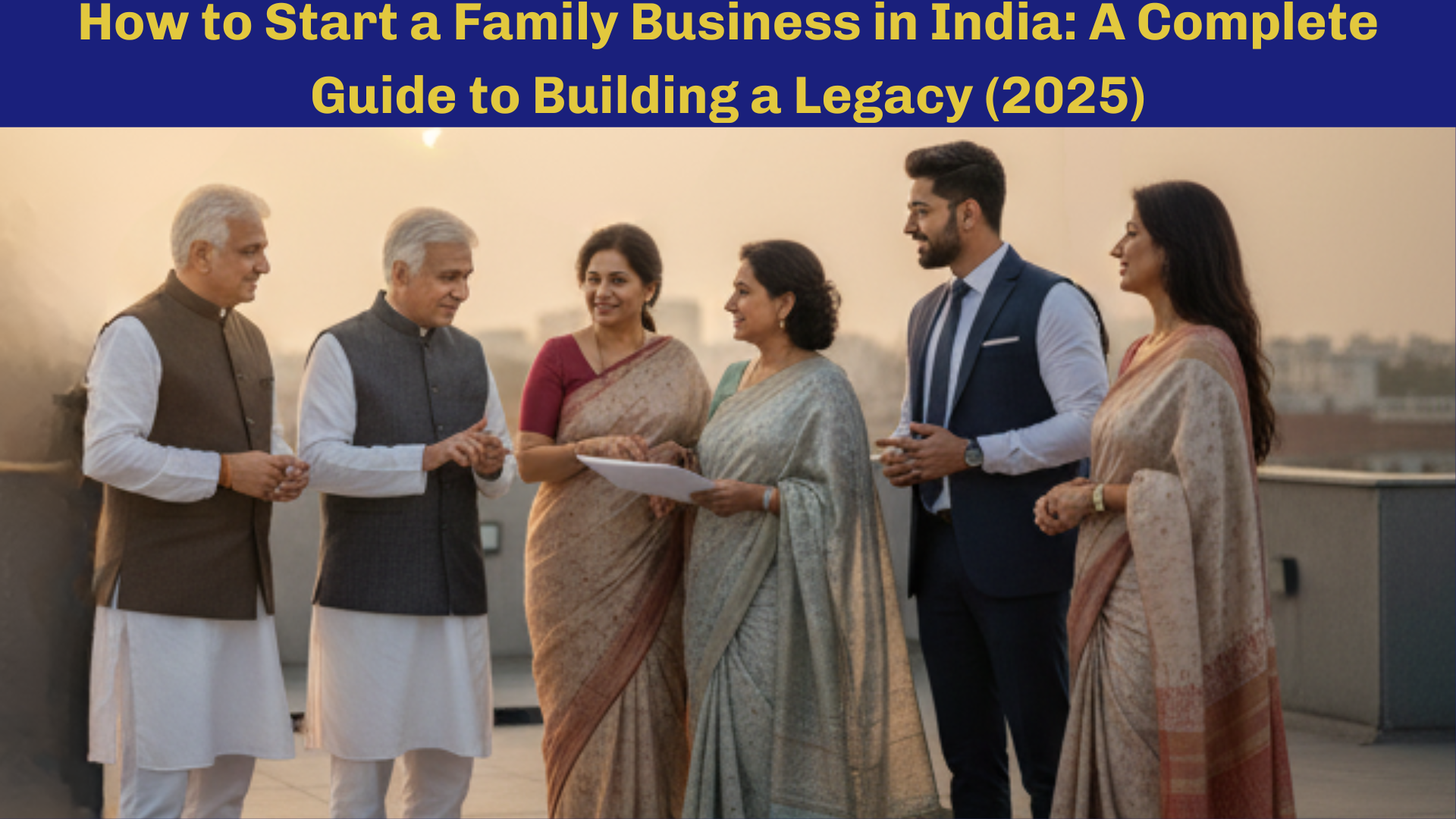The Ultimate Founder's Checklist (2025): Launch a Business This Diwali
By Filing Buddy . 08 Oct 25
Your 'Shubh Muhurat' is Now
The festive season is in the air. For most working professionals, this means a flurry of emails before a well-deserved break, bonus calculations, and the annual debate over who has to untangle the fairy lights. But for a select few, this is the quiet, super-productive window where the real work begins.
If you're reading this, you're likely one of them.
Perhaps you're a software developer in Bangalore who has been whiteboarding a solution that's ten times better than your company's current software. Maybe you're a consultant in Mumbai who has realized your client roster would happily follow you if you went solo. Or you're in a 9-to-5 job anywhere from Delhi to Hyderabad, and that "side project" in your head is starting to look more like your main act.
That persistent, brilliant idea is your 'Shubh Muhurat' - your auspicious moment to begin.
And it's not just a feeling. The festive season is a powerhouse for the Indian economy. In 2023, for instance, the Diwali season generated a record-breaking ₹3.75 lakh crore in trade. It's a time when consumer sentiment is at its peak and the market is primed for new ideas. Your personal 'Shubh Muhurat' is aligned with a national economic one.
So, what's stopping you? Ah, yes. The wall.
For most aspiring founders, the excitement of an idea is quickly followed by the dread of… well, admin. It’s the fear of the unknown, of complex government portals that look like they were designed in 1998, and of soul-crushing paperwork. It feels like being handed a complex piece of IKEA furniture with the instruction manual written in ancient Greek. This is often where great ideas go to die.
But not this time. This is where that fear gets demystified.
As your "Dhandhe ka Saathi," we've built the instruction manual. This checklist isn't just a list of tasks; it’s a strategic, step-by-step roadmap designed to take you from a brilliant concept to a legally registered, official company - ready to win your first client or pitch to an investor.
We’re going to show you how to start that journey not for lakhs, but for less than the cost of taking your team out for a single dinner.
Let's begin.
he Foundation (Your Blueprint for Success)
Every great structure needs a solid foundation. In business, that means getting your strategy right before you even think about legal registration. Skipping these initial steps is like trying to build a skyscraper on a patch of sand - it’s not a matter of if it will fall, but when.
Let’s lay the groundwork properly.
Step 1: Refine Your Business Idea into an MVP (Minimum Viable Product)
Most founders don't have an idea problem; they have an ideas problem. You probably have a dozen brilliant concepts. The first, most critical step is to pick one and sharpen it into a laser-focused tool. This is where the concept of an MVP comes in.
Think of it like building a car. A terrible MVP would be building just one perfect wheel. It’s useless on its own. A great MVP is a skateboard. It's not the fancy car you dreamed of, but it will get your user from A to B, and you'll get immediate feedback on whether the journey is even worth taking.
The goal of an MVP is to test your biggest assumption with the least amount of effort and money.
Broad Idea: "I want to create a health-tech platform."
Specific MVP: "I will create a simple WhatsApp newsletter that sends one daily 5-minute workout video to busy working professionals in Mumbai for a small subscription fee."
This is how giants are born. Zomato didn't start as a multi-billion dollar food delivery app. It started in 2008 as 'Foodiebay,' a simple website with scanned copies of restaurant menus. That was their skateboard. It proved people wanted this information online before they built the car.
Your Actionable Task: Write down your idea and then strip away every feature until you are left with only its absolute core function. That’s your starting point.
Step 2: Conduct Quick (and Smart) Market Research
"Market research" sounds like something that requires a team of analysts and a hefty budget. Let's reframe it. Think of yourself as a detective for 30 minutes. Your mission is to find out if there are real people who will pay for your product, or if you’re about to launch into a void.
According to a landmark study by CB Insights, the #1 reason startups fail (in 35% of cases) is "no market need." This 30-minute detective session is your vaccine against that fate.
A. Who is your customer? Get specific.
Don't just say "small business owners." Create a mini-profile, or a user persona.
Bad: "My customer is a cafe owner."
Good: "My customer is Rohan, a 32-year-old owner of a specialty coffee shop in Koregaon Park, Pune. He’s tech-savvy but works 12-hour days, so he’s time-poor. His biggest headache is managing the inventory for his exotic coffee beans."
Now you're not just selling a product; you're solving Rohan's specific problem.
B. Who are your competitors? Put on your spy glasses.
Pick your top two competitors and spend 15 minutes on each. Don’t just look at their website. Go straight to the comments section on their social media or the reviews on their app. What are their customers complaining about?
"Your delivery is always late."
"I wish your software integrated with X."
"The user interface is so confusing."
These complaints aren't just noise. They are your roadmap to building something better.
Step 3: Choose a Powerful Business Name
Naming your business feels like a huge, permanent decision, and it is. A great name is an asset; a bad one is a constant explanation. Before you get too attached to a name, run it through this simple 3-point check:
1. Is it Memorable & Easy to Spell? Try the "phone test." Can you say the name to someone over the phone without having to spell it out letter by letter? A name like "Flikr" famously failed this test, leading them to buy the "Flicker.com" domain later.
2. Is it Future-Proof? Naming your business "Pune's Best Brownies" is great for today, but what happens when you want to expand to Mumbai or start selling cookies? Choose a name that gives you room to grow.
3. Is it Available? Falling in love with a name before checking its availability is the business equivalent of swiping right before looking at their profile. It often ends in heartbreak. Check three places before you commit:
A) MCA Portal: To see if the official company name is available for registration.
B) Domain Registrar: To check if the .com or .in website domain is free.
C) Social Media: Check if the handles are available on Instagram, X (Twitter), and LinkedIn for a consistent brand presence.
Step 4: Decide on Your Business Structure
Choosing your legal structure is like choosing the right vehicle for a journey. The vehicle you need for a solo city commute is very different from one needed for a cross-country expedition with a full crew.
As of 2024, the Private Limited Company remains the most popular and robust structure for ambitious startups in India, with over 1.6 million active companies registered. Its popularity stems from it being a near-universal requirement for venture capital funding.
Here’s a simple way to think about your options:
One Person Company (OPC) - The Motorcycle:
Best for: Solo founders, freelancers, and consultants who want the credibility of a company with 100% control.
Key Advantage: Limited liability (your personal assets are safe) with complete ownership. It's fast, agile, and perfect for a single rider.
Limited Liability Partnership (LLP) - The Sedan:
Best for: Professional service businesses run by two or more partners (e.g., design agencies, law firms, consulting groups).
Key Advantage: It combines the operational flexibility of a partnership with the liability protection of a company. It's a comfortable, reliable ride for a small group.
Private Limited Company (Pvt. Ltd.) - The Expedition SUV:
Best for: Startups that plan to raise funding from investors, issue Employee Stock Options (ESOPs), and scale into a large organization.
Key Advantage: Highest credibility with banks and VCs, separate legal entity status, and makes it easy to add shareholders. It's built for the long haul, ready for rough terrain and a growing team.
This is a 10,000-foot view. Choosing the right structure has significant tax and legal implications. For the on-the-ground details, our comprehensive comparison guide is a must-read before you make a final decision.
Deep Dive Here: "Pvt Ltd vs LLP vs OPC" article
The Legal Blueprint (Making It Official)
Welcome to the phase that gives most aspiring founders nightmares. It’s a world filled with a sea of acronyms MCA, DSC, DIN, SPICe+ that sounds more like a secret government agency than a business registry. This is where the momentum of a great idea often grinds to a halt.
But it doesn't have to. Think of this as the final boss level in a video game that seems impossible until you have the cheat codes. We’re here to give you the cheat codes.
Step 5: Gather Your Documents
Okay, deep breath. Despite the scary-sounding process, the documents you personally need are probably already in your wallet or email inbox. The government just needs to verify who you are and where your business will operate from.
A. For Directors/Partners (Your Personal KYC):
PAN Card & Aadhaar Card: The essentials for identity and tax purposes.
A Recent Photo: A standard passport-size photograph.
Address Proof: A recent bank statement or utility bill (electricity, mobile, etc.).
Pro-Tip: This is a classic stumbling block. Ensure the name and address on your proof documents perfectly match what's on your PAN and Aadhaar. The government's verification systems are notoriously picky, and a tiny mismatch like a missing middle initial can send your application back to square one.
B. For Your Registered Office Address:
You don't need a fancy commercial office to start. You can even use your home address. You'll just need:
Proof of Address: A recent utility bill for the property.
No Objection Certificate (NOC): A simple letter from the property owner stating they have no objection to you using their address for your business. We even provide a template for this.
That’s it. No complicated financial statements, no business plans. Just standard documents you already have.
Step 6: Initiate the Company Registration Process
Here, you arrive at a crossroads. There are two paths you can take to get your Certificate of Incorporation.
Path 1: The DIY Route (The Path of the Very, Very Patient)
This path involves you personally wrestling with the Ministry of Corporate Affairs (MCA) V3 portal, a digital labyrinth where forms and patience go to get lost. You'll be applying for a Digital Signature Certificate (DSC), then a Director Identification Number (DIN), and finally, tackling the main event: the notoriously complex SPICe+ (INC-32) form.
A single mistake—a typo, a wrong code—can lead to a "resubmission" notice, kicking you to the back of the queue and delaying your launch by weeks. It’s a path that can save you a little money but costs you a fortune in your most valuable asset: your time and focus.
Path 2: The "CEO Wali Diwali" Way (The Smart Path)
In a startup ecosystem where speed is everything—India's Department for Promotion of Industry and Internal Trade (DPIIT) now recognizes over 100 new startups every single day—a delay of a few weeks can mean losing your first-mover advantage.
This is why we created a better path. It’s not just about avoiding paperwork; it’s a strategic decision to invest your energy where it generates real value: building your product, talking to customers, and making your first sale.
✨ The 'Yeh Diwali, CEO Waali' Offer ✨
Get your complete, business-ready company incorporation for just ₹999 + GST.
This isn't a stripped-down, "basic" package with hidden costs. It's your all-inclusive launch kit. While competitors might offer a similar entry price, they often charge extra for the essentials you'll need a month later. We set you up for success tomorrow, not just for registration today.
Here's what's actually included:
✅ Certificate of Incorporation
✅ Company PAN & TAN
✅ Director Identification Number (DIN) for 2 Directors
✅ MOA & AOA (Your company's constitution, expertly drafted)
✅ PF & ESIC Registration: Be compliant and ready to hire your first employee from day one.
✅ Professional Tax Registration (where applicable)
Your Shubh Muhurat is now. This weekend, you can officially become a CEO.
➡️ Start Your CEO Journey for ₹999
Step 7: Open a Dedicated Business Bank Account
Once you receive your Certificate of Incorporation from us, you’re on the home stretch. The final legal step is opening a corporate current account. This isn't just a suggestion; it’s a critical step for three reasons:
1. Legal Compliance: The Companies Act, 2013, requires you to keep your business finances separate from your personal ones. Mixing your biryani expenses with your business software subscription is a recipe for a massive accounting headache.
2. Financial Clarity: It gives you a clear picture of your company's cash flow, making tax season about 1,000 times easier.
Credibility: It's essential for receiving payments from professional clients, applying for business loans, or connecting a payment gateway like Razorpay or Stripe to your website.
Pro-Tip: With the documents we provide, you can walk into almost any major bank to open your account. Many now offer special zero-balance current accounts and welcome kits specifically for new startups. Be sure to ask about them!
The Go-To-Market Plan (Your Launch Week)
Congratulations! The government paperwork is filed, the Certificate of Incorporation is in your inbox, and you are officially a CEO. That title on your LinkedIn profile is about to get a serious upgrade.
But a CEO with no customers is just a person with a fancy business card. This next phase is about turning your legally registered company into a revenue-generating business. It’s time to go to market.
Step 8: Create a Simple Online Presence (Your Digital Storefront)
In 2025, if your business isn't online, it doesn't exist. But "being online" doesn't mean you need to spend a fortune on a 20-page website on day one. Your initial goal is simple: create a professional "digital storefront" that establishes credibility and gives you a single link to share.
According to a 2024 report from HubSpot, over 80% of buyers look up a company online before making a purchase decision. Your simple online presence is your first impression.
Option A: The Professional LinkedIn Company Page (Time: 60 minutes)
This is the fastest way to create a legitimate business profile.
Don't Just Create it, Optimize It: Use a clean logo for your profile picture and a banner that shows what you do. Write a crisp "About Us" section using the keywords your target customers (like "Rohan from Pune") would search for.
Get Your First Followers: An empty page looks abandoned. Invite your colleagues, friends, and family to be your first 20 followers. This provides instant social proof.
Option B: The One-Page Website (Time: 3-4 hours)
This gives you more control over your brand. And no, you don't need to hire a developer.
Use Modern, Simple Tools: Services like Canva Websites, Carrd, or Framer are designed for non-techies and can help you build a stunning, professional-looking single page in an afternoon.
Include Only the Essentials:
- A Killer Headline: "Accounting Services for Creative Freelancers in India."
- The Problem You Solve: "Tired of confusing tax laws and messy spreadsheets?"
- Your Solution: A brief, 2-3 sentence summary of your services.
- A Single Call-to-Action (CTA): "Book a Free 15-Minute Consultation."
Step 9: Set Up Basic Financials (Getting Ready to Get Paid)
This is the part where it all starts to feel very real. Setting up your financials isn't just about accounting; it's about creating a smooth and professional experience for your clients.
A. Decide on Your Pricing (Don't Overthink It)
Pricing paralysis is real. Don't let it delay your launch. The truth is, your initial pricing will almost certainly be wrong, and that's perfectly okay. The goal is to start somewhere.
1. For Service Businesses: A good starting point is Value-Based Pricing. Don't charge for your hours; charge for the value and the result you deliver.
2. For Product Businesses: Start with Cost-Plus Pricing. Calculate all your costs (materials, shipping, etc.) and add a healthy profit margin (e.g., 50-100%).
B. Prepare Your Invoice
A professional invoice gets you paid faster.
1. Use a Tool: While a Google Doc works, free invoicing software like Zoho Invoice or Wave makes you look more established, helps you track payments, and sends automatic reminders.
2. Must-Have Details: Ensure your invoice includes your new company name, address, GSTIN (once you have it), a unique invoice number, and clear payment details (your new corporate bank account and UPI ID).
Step 10: Plan Your Launch Day Announcement (The Big Reveal)
It's time to tell the world. This can be nerve-wracking, but it's a huge milestone. The most effective way to do this is with a personal story. According to LinkedIn's own data, posts that share a personal journey get dramatically higher engagement than generic company announcements. People connect with people, not logos.
Your LinkedIn Launch Post Mini-Template:
(The Hook - Start with your "Why")
"After 8 years in the software industry, I saw the same problem over and over: brilliant non-tech founders struggling to build their first app. I knew there had to be a better way."
(The Solution - Introduce your Company)
"That's why today, I'm incredibly excited to launch [Your Company Name]. We provide no-code development services that help founders launch their app ideas in weeks, not years."
(The Offer & The Ask - Make it engaging)
"To celebrate our launch, I'm looking for 3 ambitious founders to offer a special 25% discount on their first project. If you've been sitting on an app idea, I'd love to chat. What's the biggest thing holding you back from building it? Let me know in the comments!"
Pro-Tip: Your launch offer isn't about losing money; it's about gaining momentum. Offering a discount to your first few clients is a marketing expense that can generate the testimonials and case studies you need to win the next 50.
We can help you in this-: Read our funding guide in Detail
Conclusion: Your Journey from Founder to CEO
Let's pause for a moment.
The person who started reading this article was a professional with a nagging, brilliant idea. The person reading this now is a founder with a concrete, actionable plan.
You now know that the journey from a festive spark to a fully registered, launch-ready company isn't a treacherous mountain climb in the dark. It's a series of well-lit, manageable steps leading directly to the front door of your own business.
We've demystified the process, laid out the blueprint, and shown you the tools. The fear of paperwork, high costs, and the unknown should no longer be the gatekeeper of your ambition.
Here we are, in early October 2025. The festive lights are going up all around us. That ₹3.75 lakh crore festive economy we talked about isn't a distant forecast; it's happening right now. Your future customers are out there, the market is buzzing with optimism, and your 'Shubh Muhurat' has arrived.
Your job is to be the visionary—the creator, the strategist, the CEO.
Our job, as your "Dhandhe ka Saathi," is to be the expert in the background who handles the complex legal framework. We ensure your foundation is rock-solid so you can focus on building your empire.
Ultimately, the biggest risk isn't spending ₹999. The biggest risk is letting another year go by, another Diwali pass, with your best idea still stuck in your head.
This festive season, give your ambition the respect it deserves. Make it official.
Ready to take the first real step?
➡️ Make It Official with Our ₹999 'CEO Wali Diwali' Offer

Frequently Asked Questions (FAQs)
1. What are the key steps in a founder's checklist to start a business in India?
A comprehensive founder's checklist for India includes: 1) Refining your idea into a Minimum Viable Product (MVP), 2) Conducting market research, 3) Choosing a business name and legal structure, 4) Completing the company registration process, and 5) Creating a simple go-to-market plan.
2. Is Diwali a good time for a festive season business launch?
Yes, many consider Diwali the perfect 'Shubh Muhurat for business'. The positive consumer sentiment and increased economic activity make it an opportune moment for a festive season business launch, especially for B2C companies.
3. What is a Minimum Viable Product (MVP) and why is it on every startup checklist?
A Minimum Viable Product (MVP) is the simplest, most basic version of your product that you can launch to test your core idea with real customers. It's a critical part of any startup checklist in India because it helps validate your business blueprint before investing significant time and money.
4. What are the main differences between a Private Limited company vs LLP vs OPC?
The right business structure for startups depends on your goal. A Private Limited Company is best for raising funds. An LLP is ideal for professional service partnerships. A One Person Company (OPC) is designed for solo founders who want limited liability protection.
5. How much does it cost to start a private limited company in India?
The cost can vary, but it's now highly affordable. While some services charge more, it's possible to find an all-inclusive incorporation package or special deals like a ₹999 company registration offer during festive seasons.
6. What documents are required for Pvt Ltd company registration?
The primary documents required for pvt ltd company registration are the PAN and Aadhaar cards of all directors, address proof (like a utility bill or bank statement), and proof of the registered office address (like a rental agreement and a No-Objection Certificate).
7. What are DIN, DSC, and the SPICe+ form?
These are technical requirements for online business registration via the MCA portal. A DSC (Digital Signature Certificate) verifies your identity online, a DIN (Director Identification Number) is a unique number for each director, and the SPICe+ form is the integrated web form used for the entire incorporation process.
8. How do I register a company online for cheap in India?
To register a company online for cheap, look for reputable online company incorporation services that offer transparent, bundled packages. Comparing providers for a Diwali offer on company registration is a great way to find affordable business registration in India.
9. Is the process for startup registration in Pune different from company formation in Mumbai or Bangalore?
The central company registration process with the MCA is the same across India. However, state-specific requirements like Professional Tax registration may vary. Whether it's startup registration in Pune or starting a business in Bangalore, a good service provider will handle both central and local formalities.
10. What should I do after my company is incorporated and I receive the Certificate of Incorporation?
After you receive your Certificate of Incorporation, the immediate next steps are to open a corporate bank account, apply for any necessary licenses (like GST), and begin executing your business launch checklist, starting with your online presence and customer outreach.
11. What are the prerequisites for seed funding for a newly registered company?
Key seed funding prerequisites include a legally registered and compliant company (usually a Pvt. Ltd.), a clear business blueprint, a defined MVP with some initial traction or market validation, and a strong founding team. Many founders begin by bootstrapping their startup before seeking external funds.
12. What's the fastest way to register a company online?
The fastest way to register a company online is to use a professional service that handles all the paperwork efficiently. With all documents in order, the process can be completed in as little as 7-10 working days, from name approval to receiving your incorporation certificate.
13. What should be included in an all-inclusive incorporation package?
A good all-inclusive incorporation package should cover more than just the name. It must include Director Identification Numbers (DINs), Digital Signature Certificates (DSCs), expert drafting of your Articles of Association (AOA), the official Certificate of Incorporation, and company PAN & TAN.
14. What are some popular Diwali business ideas for 2025?
Some popular Diwali business ideas for 2025 include personalized corporate gifting services, sustainable and artisanal home decor e-commerce stores, gourmet sweet and snack boxes with a modern twist, and event management services for festive parties.
Contact Us
An expert will call you within 24 hours. No payment required to get started.
Related Post

Private Limited Company Registration in India (2025) – Fees, Process & Documents
Learn how to register a Private Limited Company in India in 2025. Discover costs, required documents, step-by-step process, timelines, and compliance tips.
. 6 Minutes
Launch Your Startup This Diwali | A Shubh Muhurat Guide | Filing Buddy
Thinking of launching your startup? Discover why Diwali 2025 is the perfect 'shubh muhurat for business'. Our guide covers the benefits & how to start for just ₹999.
. 3 minutes
Start a Family Business in India | Step-by-Step Guide (2025)
Ready to start a family business in India? Our in-depth guide covers legal structures (LLP vs Pvt Ltd), governance, and succession planning. Learn from real-world examples.
. 3 minutes

